1963ss07
1963ss07.docx
NESHAP for Organic Liquids Distribution (Non-Gasoline) Facilities (40 CFR part 63, subpart EEEE) (Proposed Rule)
OMB: 2060-0539
SUPPORTING STATEMENT
ENVIRONMENTAL PROTECTION AGENCY
Risk and Technology Review of the National Emission Standards for Hazardous Air Pollutants for Organic Liquid Distribution (Non-Gasoline)
IDENTIFICATION OF THE INFORMATION COLLECTION
1(a) Title of the Information Collection
Risk and Technology Review of the National Emission Standards for Hazardous Air Pollutants for Organic Liquid Distribution (Non-Gasoline) (40 CFR part 63, subpart EEEE), EPA ICR Number 1963.07, OMB Control Number 2060-0539.
1(b) Short Characterization/Abstract
This supporting statement addresses information collection activities that will be imposed by proposed amendments to the National Emission Standards for Hazardous Air Pollutants (NESHAP) for Organic Liquid Distribution (Non-Gasoline) (OLD), 40 CFR part 63, subpart EEEE. The current OLD NESHAP was promulgated on February 3, 2004.
As part of the residual risk and technology review for the NESHAP, the Environmental Protection Agency (EPA) is revising requirements for storage tanks and flares and adding requirements for connector monitoring. The EPA is also proposing amendments to correct and clarify regulatory provisions related to emissions during periods of startup, shutdown, and malfunction (SSM); and add requirements for electronic reporting of performance test results and reports and compliance reports; and add requirements and clarifications for periods of control device bypasses, including bypass lines. This information collection request documents the recordkeeping and reporting requirements and burden imposed by these proposed amendments only.
In general, all NESHAP standards require initial notifications, performance tests, and periodic reports by the owners/operators of the affected facilities. These notifications, reports, and records are essential in determining compliance and are required of all affected facilities subject to NESHAP. This information collection request (ICR) includes the burden for all activities that will be conducted in the first three years following promulgation of the proposed amendments to the OLD standards. These activities include reading the rule, installing and maintaining monitors, and completing the recordkeeping and reporting requirements.
Any owner/operator subject to the provisions of this part shall maintain a file of these notifications, reports, and records, and retain the file for at least five years. All reports are sent to the delegated state or local authority. In the event there is no such delegated authority, the reports are sent directly to the EPA regional office. The use of the term "Designated Administrator" throughout this document refers to the U.S. EPA or a delegated authority such as a state agency. The term "Administrator" alone refers to the U.S. EPA Administrator.
Over the next three years, 181 OLD facilities will be subject to this standard, and the total labor, capital, and operations and maintenance costs imposed by the proposed amendments will be approximately $820,000 per year for the first 3 years after the proposed amendments are finalized. The burden to the respondents from each facility is shown in Tables 1 through 4 in Attachment 1.
The total average annual cost to the Designated Administrator during the 3 years of the ICR is estimated to be $51,000 per year. This burden includes labor costs for the Federal EPA and state and local authorities to implement the requirements in the NESHAP after the proposed amendments are finalized. This burden is shown in Tables 5 through 8 of Attachment 2.
2. Need for and Use of the Collection
2(a) Need/Authority for the Collection
The EPA is charged under CAA Section 112, as amended, to establish standards of performance for each category or subcategory of major sources and area sources of hazardous air pollutants (HAP). These standards are applicable to new or existing sources of HAP and require the maximum degree of emission reduction. In addition, CAA section 114(a) states that the Administrator may require any owner/operator subject to any requirement of this Act to:
(A) Establish and maintain such records; (B) make such reports; (C) install, use, and maintain such monitoring equipment, and use such audit procedures, or methods; (D) sample such emissions (in accordance with such procedures or methods, at such locations, at such intervals, during such periods, and in such manner as the Administrator shall prescribe); (E) keep records on control equipment parameters, production variables or other indirect data when direct monitoring of emissions is impractical; (F) submit compliance certifications in accordance with Section 114(a)(3); and (G) provide such other information as the Administrator may reasonably require.
In the Administrator's judgment, HAP emissions from miscellaneous organic chemical manufacturing facilities cause or contribute to air pollution that may reasonably be anticipated to endanger public health or welfare. Therefore, the NESHAP were promulgated for major sources in this source category at 40 CFR part 63, subpart EEEE.
2(b) Practical Utility/Users of the Data
The recordkeeping and reporting information will be used by Designated Administrators to ensure compliance with the applicable regulations, which were promulgated in accordance with the Clean Air Act. The collected information is also used for targeting inspections and as evidence in legal proceedings.
Continuous monitors, along with the other required monitoring, are used to ensure compliance with the standards at all times.
The required notifications are used to inform the Designated Administrator when a source becomes subject to the requirement of the regulations. The reviewing authority may then inspect the source to ensure that monitors are properly installed and operated and the standards are being met.
The required semiannual reports and records are used to determine periods of excess emissions, identify problems at the facility, verify operation and maintenance procedures, and determine compliance.
3. Nonduplication, Consultations, and Other Collection Criteria
The requested recordkeeping and reporting will be required under 40 CFR part 63, subpart EEEE.
3(a) Nonduplication
If the subject standards have not been delegated, the information is sent directly to the appropriate EPA regional office. Otherwise, the information is sent directly to the delegated state or local agency. If a state or local agency has adopted its own similar standards to implement the Federal standards, a copy of the report submitted to the state or local agency can be sent to the Administrator in lieu of the report required by the Federal standards. Therefore, no duplication exists.
3(b) Public notice prior to ICR submission to OMB
A public notice of this collection is provided in the Federal Register notice of proposed rulemaking published for the OLD NESHAP.
3(c) Consultations
The public will be provided the opportunity to review and comment on the burden estimated in this Information Collection Request during the comment period for the proposed rulemaking.
3(d) Effects of Less Frequent Data Collection
The OLD requires continuous monitoring and semiannual compliance reports. These periodic reports are essential to enforcement of the standards and detection of violations. The ongoing recordkeeping requirements also ensure that monitoring equipment is properly maintained and enhances the reliability of the data that is gathered for this collection.
3(e) General Guidelines
These reporting or recordkeeping requirements do not violate any of the regulations promulgated by OMB under 5 CFR part 1320, section 1320.5.
The OLD NESHAP requires owners or operators of facilities to keep and maintain records for a period of five years. The title V permit programs also require records to be retained for five years. These records must be kept on file for use, if needed, by the regulating authority to ensure that the plant personnel are operating and maintaining control equipment properly.
3(f) Confidentiality
All information submitted to the Agency for which a claim of confidentiality is made will be safeguarded according to the Agency policies set forth in 40 CFR 2, subpart B -- Confidentiality of Business Information (see 40 CFR 2; 41 FR 36902, September 1, 1976, amended by 43 FR 39999, September 28, 1978; 43 FR 42251, September 28, 1978; 44 FR 17674, March 23, 1979).
3(g) Sensitive Questions
The reporting or recordkeeping requirements in the standard do not include sensitive questions.
4. THE RESPONDENTS AND THE INFORMATION REQUESTED
4(a) Respondents/NAICS Codes
The respondents to the recordkeeping and reporting requirements are organic liquid distribution (non-gasoline) facilities. OLD facilities can be either stand-alone liquid terminals or organic liquid distribution operations collocated with other industrial sources. The North American Industry Classification System (NAICS) codes for the respondents affected by the standards are listed in the table below, but note that this list is not exhaustive.
Standard (40 CFR Part 63, Subpart EEEE) |
NAICS Codes |
Converted Paper Product Manufacturing |
3222 |
Petroleum and Coal Products Manufacturing |
3241 |
Basic Chemical Manufacturing |
3251 |
Resin, Synthetic Rubber, and Artificial Synthetic Fibers and Filaments Manufacturing |
3252 |
Other Chemical Product and Preparation Manufacturing |
3259 |
Plastics Product Manufacturing |
3261 |
Motor Vehicle Manufacturing |
3361 |
Motor Vehicle Body and Trailer Manufacturing |
3362 |
Other Miscellaneous Manufacturing |
3399 |
Petroleum and Petroleum Products Merchant Wholesalers |
4247 |
Pipeline Transportation of Crude Oil |
4861 |
Other Pipeline Transportation |
4869 |
Warehousing and storage |
4931 |
Waste Treatment and Disposal |
5622 |
4(b) Information Requested
(i) Data Items
In this ICR, all data that are recorded or reported is required by the OLD (40 CFR, part 63, subpart EEEE). The tables below reflect the proposed amendments.
A source must make the following reports:
Notifications/Reports |
|
Notification of compliance status |
|
Storage tanks |
63.2343(b) |
Connectors |
Table 12 to Subpart EEEE of Part 63 (63.9(h) in General Provisions) |
Flares |
63.2382(d) |
Periodic reports |
|
Storage tanks |
63.2343(b) |
Connectors |
Item 1.b of Table 11 to subpart EEEE of Part 63 |
Flares |
63.2386(c) and (d) |
A source must keep the following records:
Recordkeeping |
|
Each notification and report |
Table 12 to Subpart EEEE of Part 63 (63.10 in General Provisions) |
Records of storage tanks, connectors, flares, and bypass lines |
63.2343(b) and (e); 63.2390 (b), (f), (g), and (h) |
Electronic Reporting
Some of the respondents are using monitoring equipment that automatically records
parameter data. Although personnel at the affected facility must still evaluate the data, internal
automation has significantly reduced the burden associated with monitoring and recordkeeping at
a plant site.
(ii) Respondent Activities
Respondent Activities |
Read instructions. |
Acquire, install, and operate monitoring devices for flares and storage tanks. |
Conduct performance tests, if applicable. |
Adjust the existing ways to comply with any previously applicable instruction and requirements. |
Write the notifications and reports listed above. |
Enter information required to be recorded above. |
Submit the required reports developing, acquiring, installing, and utilizing technology and systems for the purpose of collecting, validating, and verifying information. |
Develop, acquire, install, and utilize technology and systems for the purpose of processing and maintaining information. |
Develop, acquire, install, and utilize technology and systems for the purpose of disclosing and providing information. |
Train personnel to be able to respond to a collection of information. |
Transmit, or otherwise disclose the information. |
5. THE INFORMATION COLLECTED -- AGENCY ACTIVITIES, COLLECTION, METHODOLOGY, AND INFORMATION MANAGEMENT
5(a) Agency Activities
EPA conducts the following activities in connection with the acquisition, analysis, storage, and distribution of the required information.
5(b) Collection Methodology and Management
Data and records maintained by the respondents are tabulated and published for use in compliance and enforcement programs. The semiannual reports are used for problem identification, as a check on source operation and maintenance, and for compliance determinations.
Information contained in the reports is reported by state and local governments in the ICIS Air database, which is operated and maintained by EPA's Office of Compliance. ICIS is EPA’s database for the collection, maintenance, and retrieval of compliance data for industrial and government-owned facilities. EPA uses ICIS for tracking air pollution compliance and enforcement by local and state regulatory agencies, EPA regional offices and EPA headquarters. EPA and its delegated Authorities can edit, store, retrieve and analyze the data.
The records required by this regulation must be retained by the owner/operator for five years.
5(c) Small Entity Flexibility
A majority of the respondents are large entities (i.e., large businesses). However, the impact on small entities (i.e., small businesses) was taken into consideration during the development of the regulation. Due to technical considerations involving the process operations and the types of control equipment employed, the recordkeeping and reporting requirements are the same for both small and large entities. The Agency considers these to be the minimum requirements needed to ensure compliance and, therefore, cannot reduce them further for small entities. To the extent that larger businesses can use economies of scale to reduce their burden, the overall burden will be reduced.
5(d) Collection Schedule
Upon promulgation of the proposed amendments, owners or operators of OLD facilities have up to three years to comply with the reporting and recordkeeping requirements associated with the proposed amendments for storage tanks, connectors, flares, and periods of control device bypass. Most facilities are expected to use the full three years to comply with the requirements, but it was assumed that one-third of the facilities would begin complying in year 2 and the remaining facilities in year 3. The specific frequency for each information collection activity within this request is shown in Tables 1 through 3 of Attachment 1.
6. ESTIMATING THE BURDEN AND COST OF THE COLLECTION
Tables 1 through 4 of Attachment 1 present an itemization of the burden on the respondents subject to this NESHAP for the recordkeeping and reporting requirements in the first three years following promulgation of the proposed amendments to the OLD NESHAP. Tables 5 through 8 of Attachment 2 present a summary of the burden on the Federal EPA and state and local authorities in the first three years following promulgation of the proposed amendments to the OLD NESHAP.
The individual burdens are expressed under standardized headings believed to be consistent with the concept of burden under the Paperwork Reduction Act. Where appropriate, specific tasks and major assumptions have been identified. Responses to this information collection are mandatory.
The agency may not conduct or sponsor, and a person is not required to respond to, a collection of information unless it displays a currently valid OMB Control Number.
6(a) Estimating Respondent Burden
The average annual burden to industry over the next three years from these recordkeeping and reporting requirements is estimated to be 5,967 hours. The average annual recordkeeping hours are 3,123 and the reporting requirement hours are 2,844, both of which are shown in Table 4 of Attachment 1. These hours are based on review of background documents in development of the proposed amendments to this NESHAP, Agency knowledge and experience with the NESHAP program, and related ICRs.
6(b) Estimating Respondent Costs
The information collection activities for sources subject to these requirements are presented in Tables 1 through 4 of Attachment 1. The total cost for each respondent activity includes labor costs, capital/startup costs, and operating and maintenance (O&M) costs.
(i) Estimating Labor Costs
This ICR uses the following labor rates:
Managerial $143.56 ($68.36 + 110%)
Technical $104.90 ($49.95 + 110%)
Clerical $43.39 ($20.66 + 110%)
These rates are from the United States Department of Labor, Bureau of Labor Statistics, May 2016, “National Industry-Specific Occupational Employment and Wage Estimates, NAICS 325000 - Chemical Manufacturing.” The rates are from column 8, mean hourly wage. The rates have been increased by 110 percent to account for the benefit packages available to those employed by private industry.
(ii) Estimating Capital/Start-up and Operation and Maintenance Costs
In addition to the labor costs mentioned above, industry costs associated with the information collection activities in the OLD include capital/start-up costs and operation and maintenance costs associated with continuous monitoring. The capital/startup costs are one-time costs when a facility becomes subject to the regulation and include the installation of monitors. The annual operation and maintenance costs are the ongoing costs to maintain the monitors and complete performance evaluations, as well as other costs such as photocopying and postage.
(iii) Capital/Startup and Operation and Maintenance (O&M) Costs
Below are the estimated capital and startup costs and O&M costs for the respondents subject to the OLD for the first three years after promulgation of the proposed amendments.
Capital/Startup and O&M Costs |
||||||
(A) Unit Type |
(B) Capital/Startup Costs for One Respondent |
(C) Number of Respondents with Capital/Startup Costs |
(D) Total Capital/ Startup Cost (B X C) |
(E) Annual Cost (O&M and Capital) for One Respondent |
(F) Number of Respondentsa |
(G) Total Annual Cost, (E X F) |
Storage Tanks - HAP Content |
||||||
Initial Monitoring |
$0 |
0 |
$0 |
$2,828 |
40 |
$113,120 |
Retest |
$0 |
0 |
$0 |
$1,257 |
4 |
$5,028 |
Storage Tanks - Vapor Pressure |
||||||
Monitor |
$7,440 |
40 |
$297,600 |
$964 |
53 |
$51,066 |
Initial Monitoring |
$0 |
0 |
$0 |
$413 |
40 |
$16,520 |
Retest |
$0 |
0 |
$0 |
$182 |
4 |
$728 |
Flare Monitors |
$12,000 |
16 |
$192,000 |
$22,000 |
21 |
$462,000 |
TOTAL |
|
|
$489,600 |
|
|
$648,462 |
Within a given year, there are a maximum of 201 respondents per information collection activity, however the values in column F reflect the sum of these respondents for years 2 and 3.
The total capital/startup costs for this ICR are $489,600; this is the total of column D.
The total annual costs for this ICR are $648,000; this is the total of column G. This includes O&M and annualized capital costs.
6(c) Estimating Agency Burden and Cost
The costs to the Agency are those costs associated with analysis of the reported information. The Agency’s overall compliance and enforcement program includes activities such as the examination of records maintained by the respondents, periodic inspection of sources of emissions, and the publication and distribution of collected information.
The average annual Agency cost during the three years of the ICR is estimated to be $51,000.
This cost is based on the average hourly labor rates as follows:
Managerial $64.16 (GS-13, Step 5, $40.10+ 60%)
Technical $47.62 (GS-12, Step 1, $29.76+ 60%)
Clerical $25.76 (GS-6, Step 3, $16.10 + 60%)
These rates are from the Office of Personnel Management (OPM), 2016 General Schedule, which excludes locality rates of pay. The rates have been increased by 60 percent to account for the benefit packages available to government employees. Details on the line item estimates used to calculate these burdens are presented in Tables 5 through 8 of Attachment 2.
6(d) Estimating the Respondent Universe and Total Burden and Costs
The total number of respondents is also referred to as the respondent universe. Based on research conducted for the residual risk and technology reviews of the OLD, 181 facilities are currently operating and subject to the standards. It was assumed that one-third of the facilities would begin complying with the proposed amendments in year 2 and the remaining two-thirds of the facilities would begin complying in year 3.
The total number of annual responses is calculated using the following table:
Total Annual Responses |
||||
(A) |
(B) |
(C) |
(D) |
(E) |
Information Collection Activity |
Number of Respondents |
Number of Responses |
Number of Existing Respondents That Keep Records But Do Not Submit Reports |
Total
Annual Responses |
Notification of Compliance Status |
||||
Storage Tanks |
40 |
1 |
0 |
40 |
Connectors |
180 |
1 |
0 |
180 |
Flares |
16 |
1 |
0 |
16 |
Periodic Reports |
||||
Storage Tanks |
53 |
2 |
0 |
106 |
Connectors |
240 |
2 |
0 |
480 |
Flares |
21 |
2 |
0 |
42 |
TOTAL |
|
|
|
864 |
The number of total annual responses is 864.
6(e) Bottom Line Burden Hours and Cost Tables
(i) The Respondent Tally
The total annual labor hours for respondents are 17,902 at a cost of $1.8 million. Furthermore, the annual public reporting and recordkeeping burden for this collection of information is estimated to average 21 hours per response. Details regarding these estimates may be found in Tables 1 through 4 of Attachment 1.
The total annual capital/startup and O&M costs to the regulated entity are $648,000. The cost calculations are detailed in Section 6(b)(iii), Capital/Startup vs. Operation and Maintenance Costs.
(ii) The Agency Tally
The average annual burden over the first three years for the Agency is estimated to be 1,097 hours at a cost of $50,900. The Agency burden hours and costs are presented in Tables 5 through 8 of Attachment 2.
6(f) Reasons for change in burden
As part of the residual risk and technology review for the NESHAP, the Environmental Protection Agency (EPA) is revising requirements for storage tanks and flares and adding requirements for connector monitoring. The EPA is also proposing amendments to correct and clarify regulatory provisions related to emissions during periods of startup, shutdown, and malfunction (SSM); and add requirements for electronic reporting of performance test results and reports and compliance reports; and add requirements and clarifications for periods of control device bypasses, including bypass lines. This information collection request documents the recordkeeping and reporting requirements and burden imposed by these proposed amendments only.
6(g) Burden Statement
The annual public reporting and recordkeeping burden for this collection of information is estimated to be 21 hours per response. Burden means total time, effort, or financial resources expended by persons to generate, maintain, retain, or disclose or provide information to or for a Federal agency. This includes the time needed to review instructions; develop, acquire, install, and utilize technology and systems for the purposes of collecting, validating, and verifying information, processing and maintaining information, and disclosing and providing information; adjust the existing ways to comply with any previously applicable instructions and requirements; train personnel to be able to respond to a collection of information; search data sources; complete and review the collection of information; and transmit or otherwise disclose the information.
An agency may not conduct or sponsor, and a person is not required to respond to, a collection of information unless it displays a currently valid OMB control number. The OMB Control Numbers for EPA regulations are listed in 40 CFR part 9 and 48 CFR chapter 15.
To comment on the agency's need for this information, the accuracy of the provided burden estimates, and any suggested methods for minimizing respondent burden, including the use of automated collection techniques, the EPA has established a public docket for this ICR under Docket ID Number EPA-HQ-OAR-2018-0074. An electronic version of the public docket is available at http://www.regulations.gov/ which may be used to obtain a copy of the draft collection of information, submit or view public comments, access the index listing of the contents of the docket, and to access those documents in the public docket that are available electronically. When in the system, select “search,” then key in the docket ID number identified in this document. The documents are also available for public viewing at the Enforcement and Compliance Docket and Information Center in the EPA Docket Center (EPA/DC), EPA West, Room 3334, 1301 Constitution Ave., NW, Washington, DC. The EPA Docket Center Public Reading Room is open from 8:30 a.m. to 4:30 p.m., Monday through Friday, excluding legal holidays. The telephone number for the Reading Room is (202) 566-1744, and the telephone number for the docket center is (202) 566-1927. Also, you can send comments to the Office of Information and Regulatory Affairs, Office of Management and Budget, 725 17th Street, NW, Washington, DC 20503, Attention: Desk Officer for EPA. Please include the EPA Docket ID Number EPA-HQ-OAR-2018-0074 and OMB Control Number 2060-0539 in any correspondence.
PART B OF THE SUPPORTING STATEMENT
This section is not applicable because statistical methods are not used in data collection associated with this regulation.
ATTACHMENT 1
TABLES 1, 2, 3, and 4
Tables 1 - 3: Annual Respondent Burden and Cost of Recordkeeping and Reporting Requirements for the Organic Liquid Distribution (Non-Gasoline) RTR – Years 1-3
Table 4: Summary of Annual Respondent Burden and Cost of Recordkeeping and Reporting Requirements for the Organic Liquid Distribution (Non-Gasoline) RTR
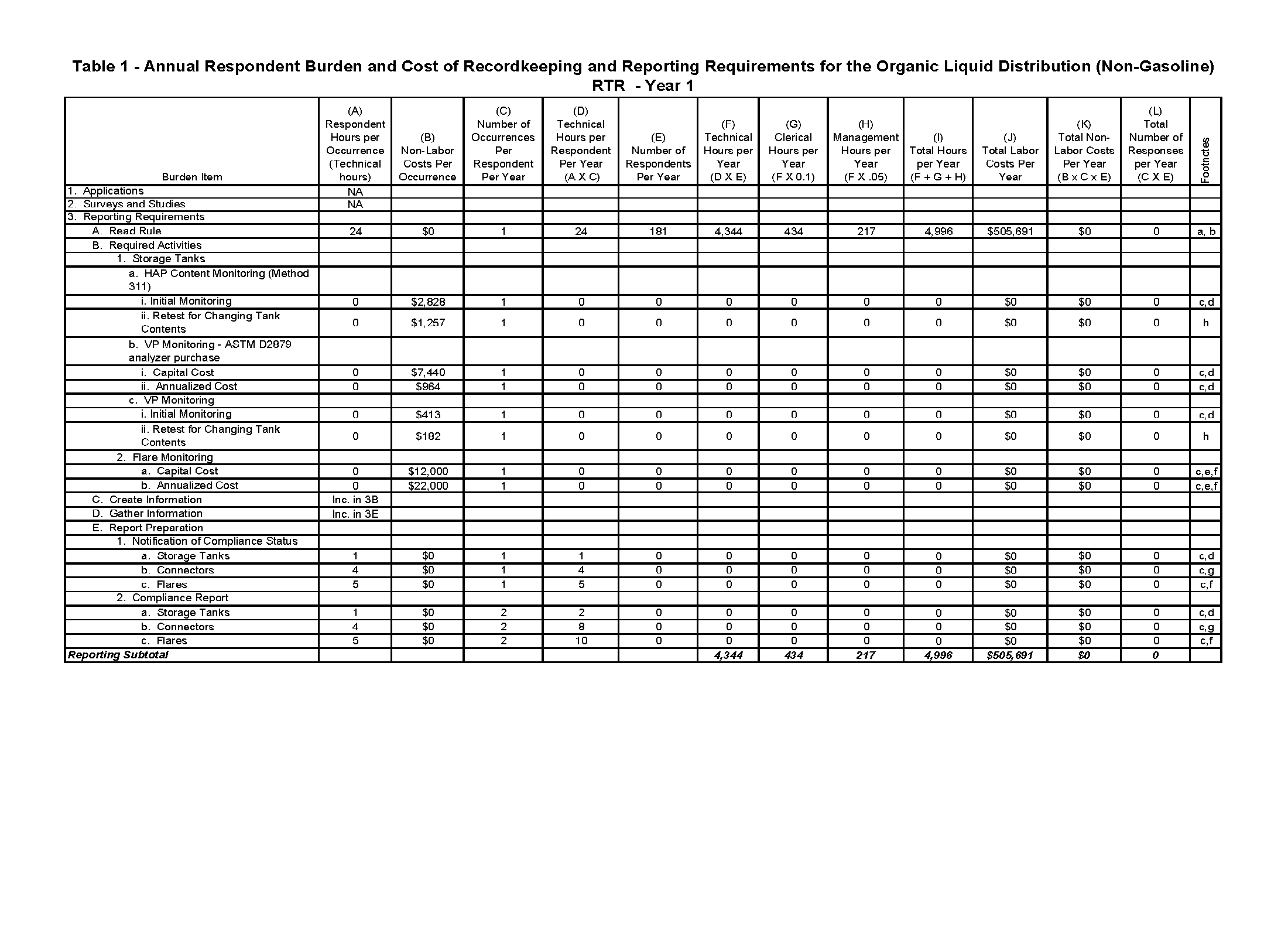
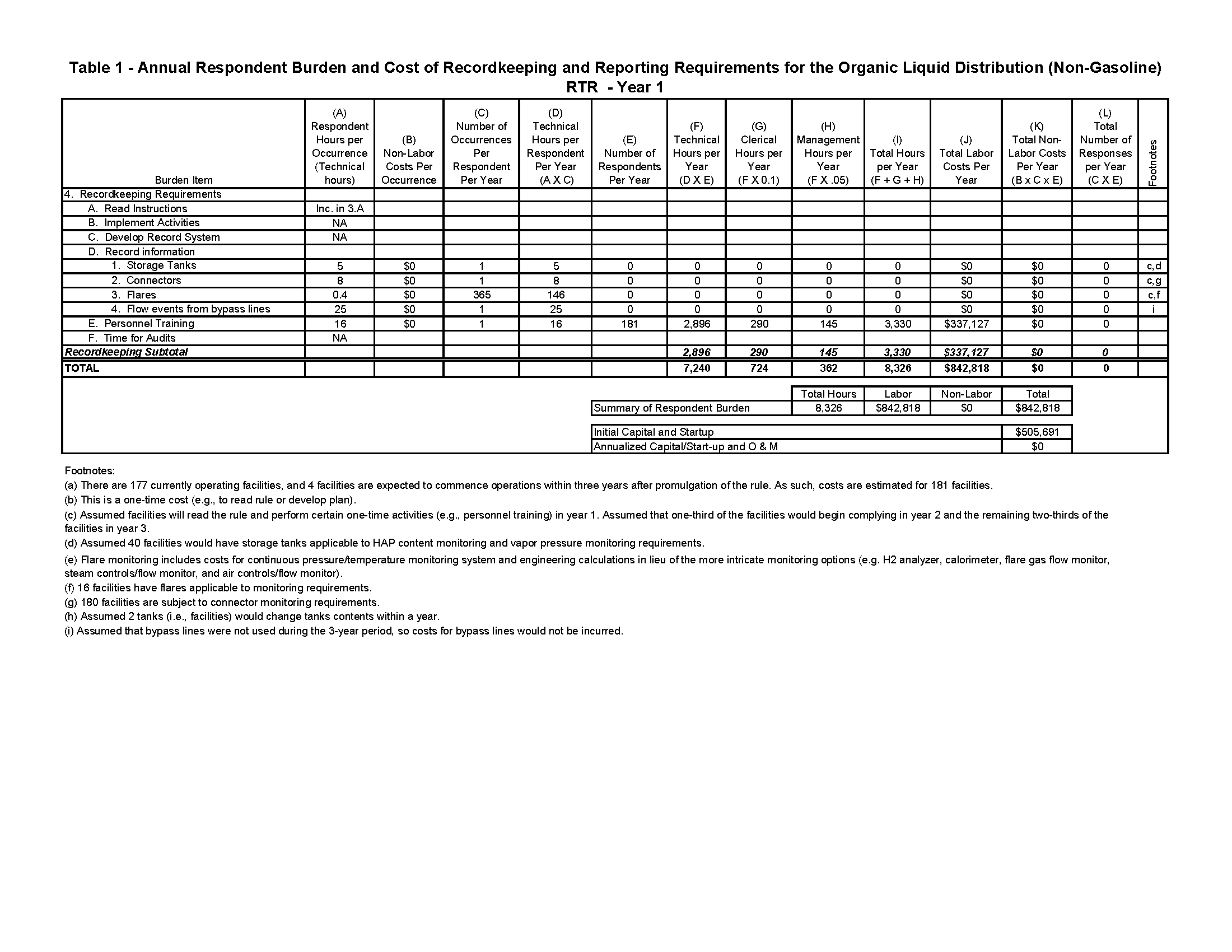
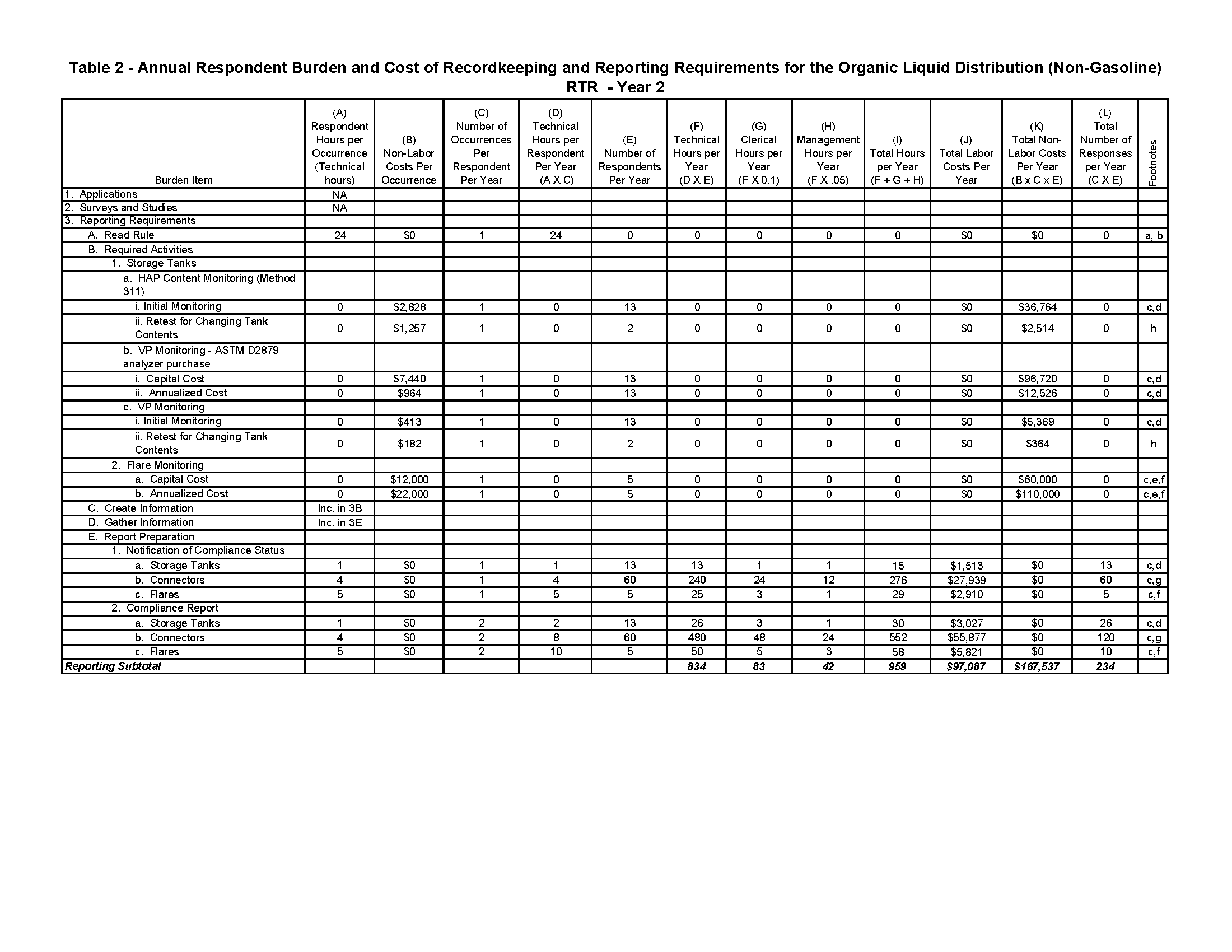
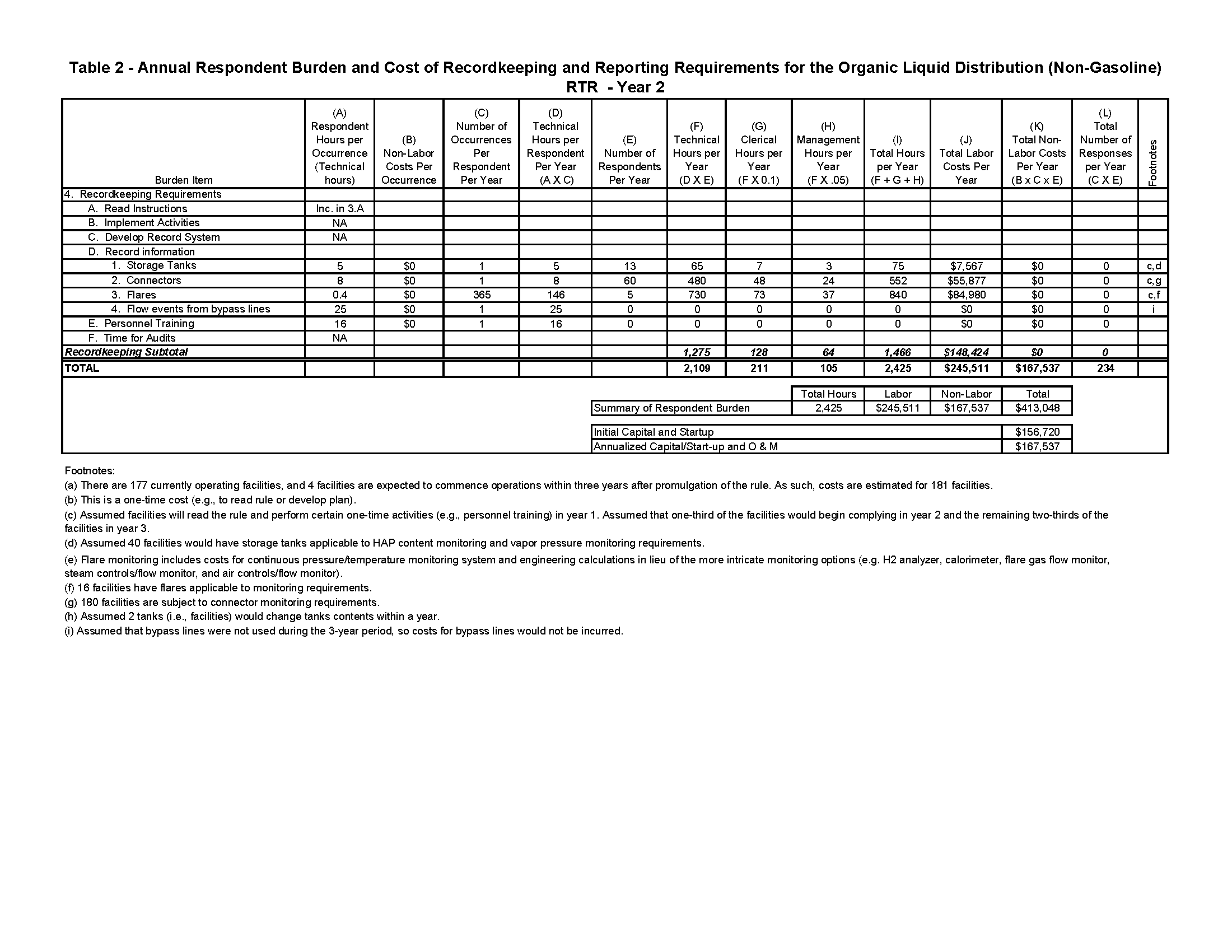
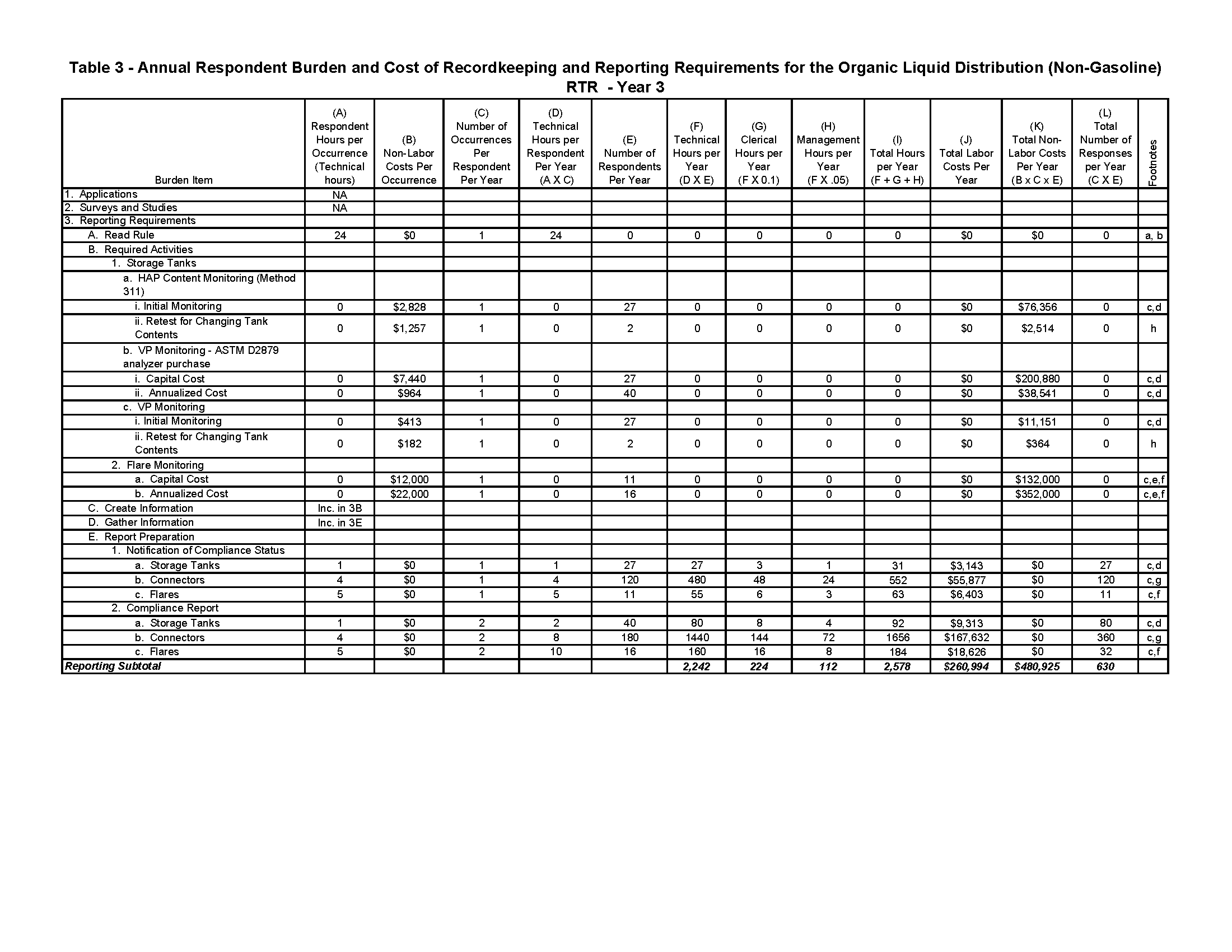
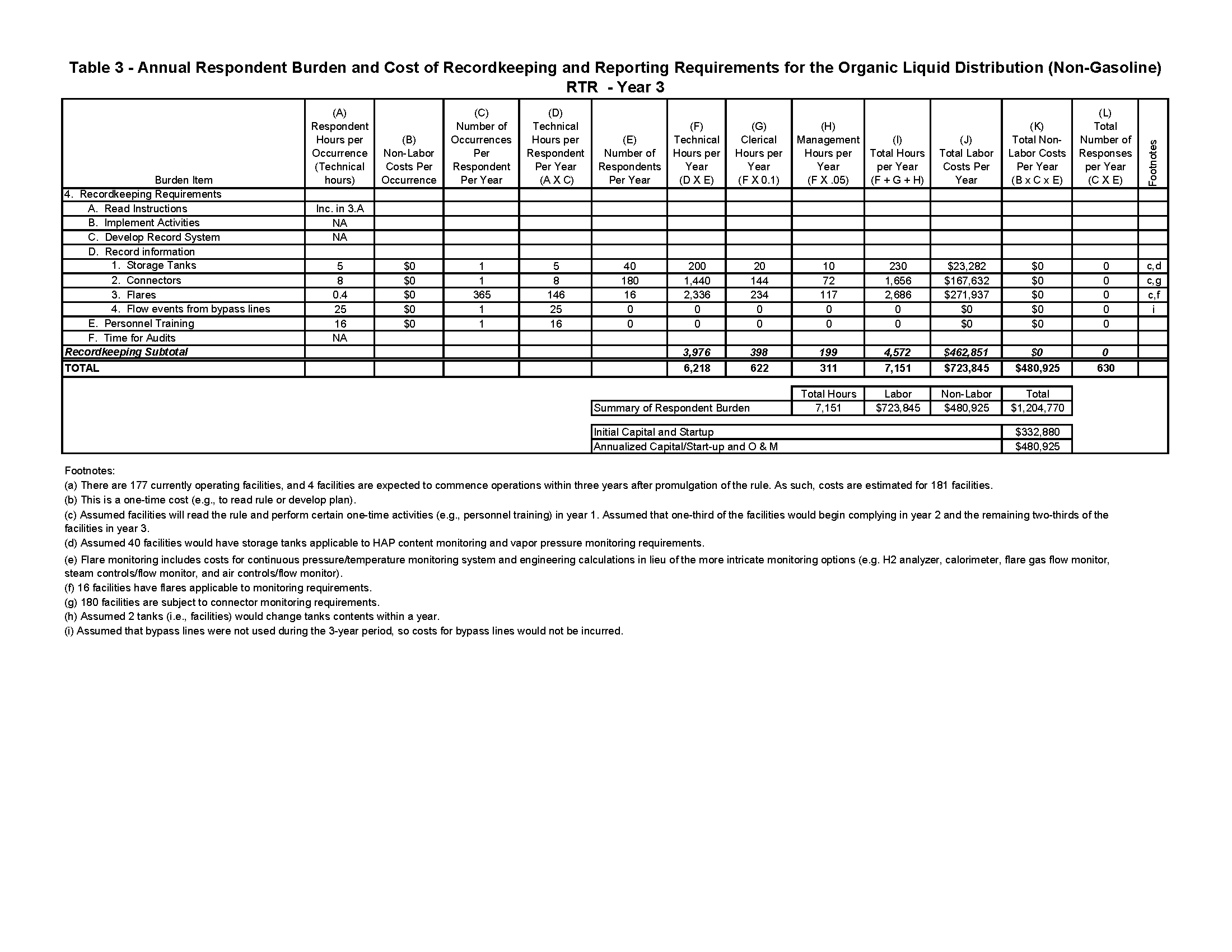
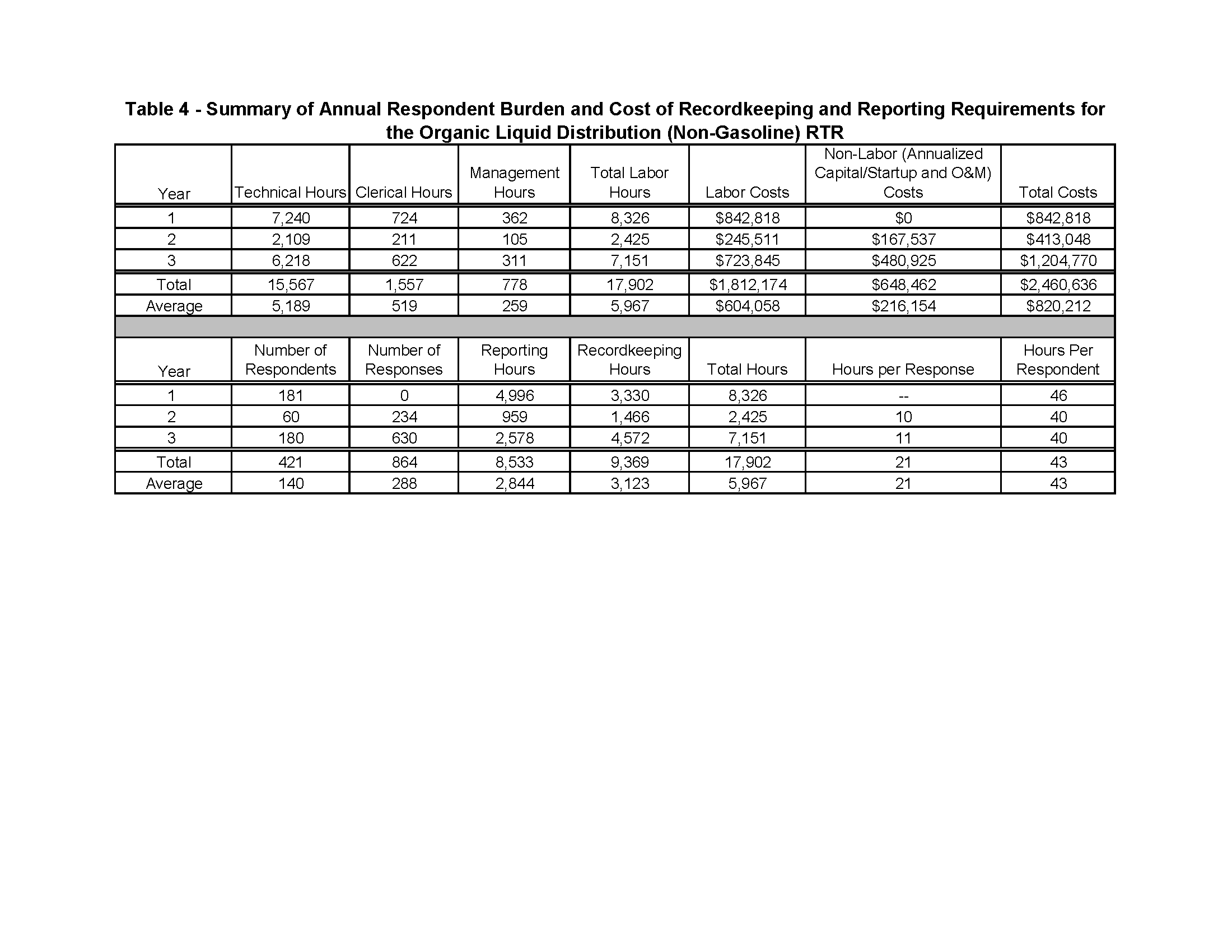
ATTACHMENT 2
TABLES 5, 6, 7, and 8
Tables 5 - 7: Annual Agency Burden and Cost of Recordkeeping and Reporting Requirements for the Organic Liquid Distribution (Non-Gasoline) RTR - Year 1-3
Table 8: Summary of Annual Agency Burden and Cost of Recordkeeping and Reporting Requirements for the Organic Liquid Distribution (Non-Gasoline) RTR
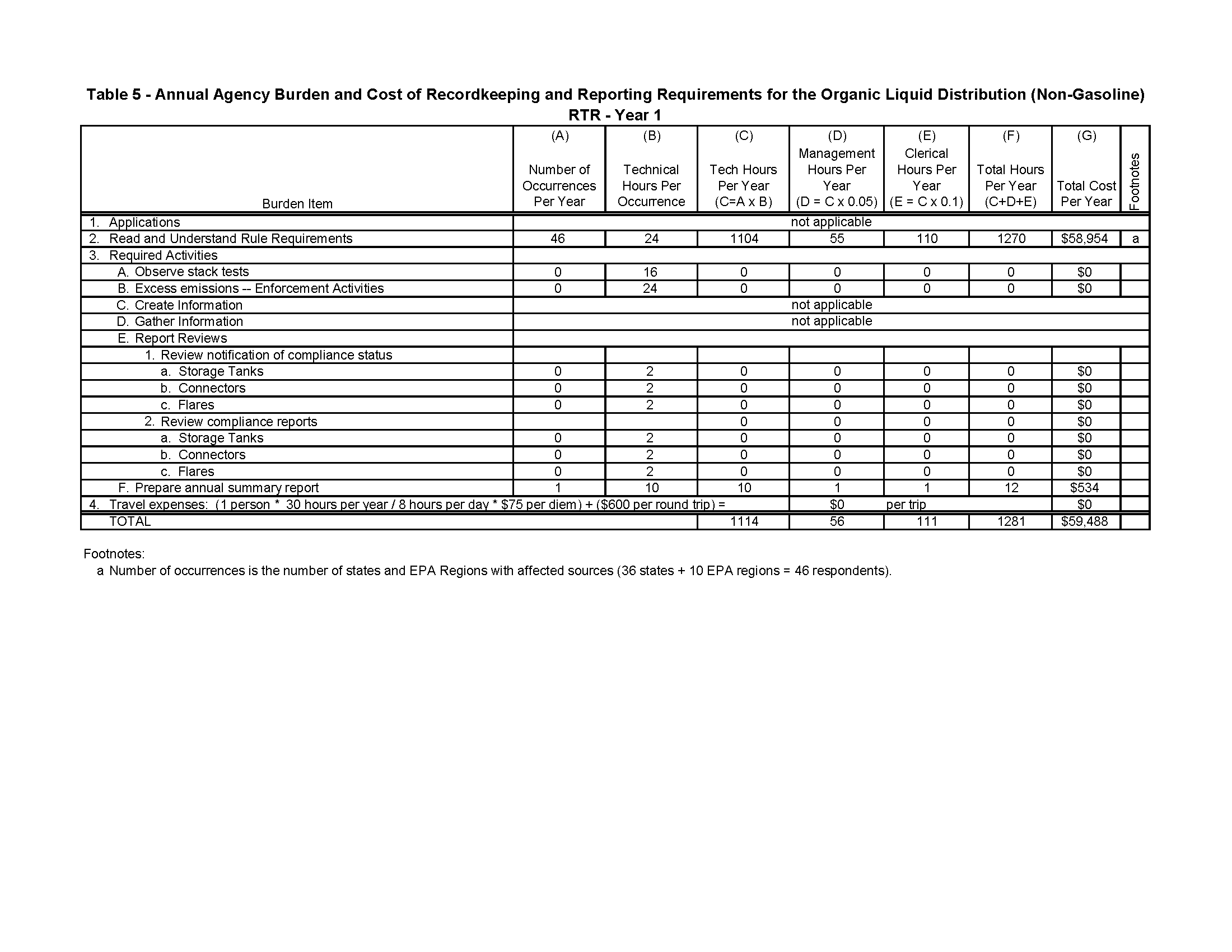
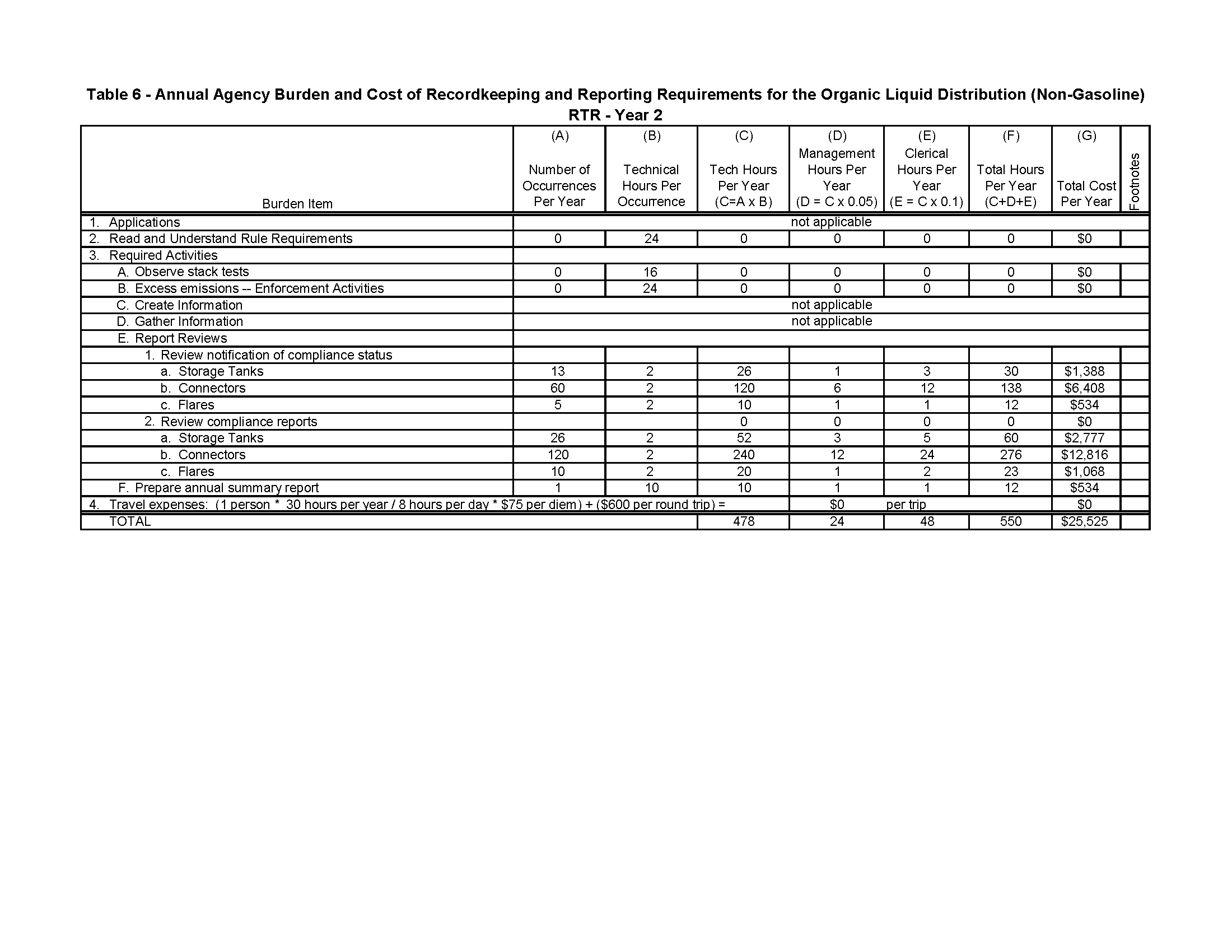
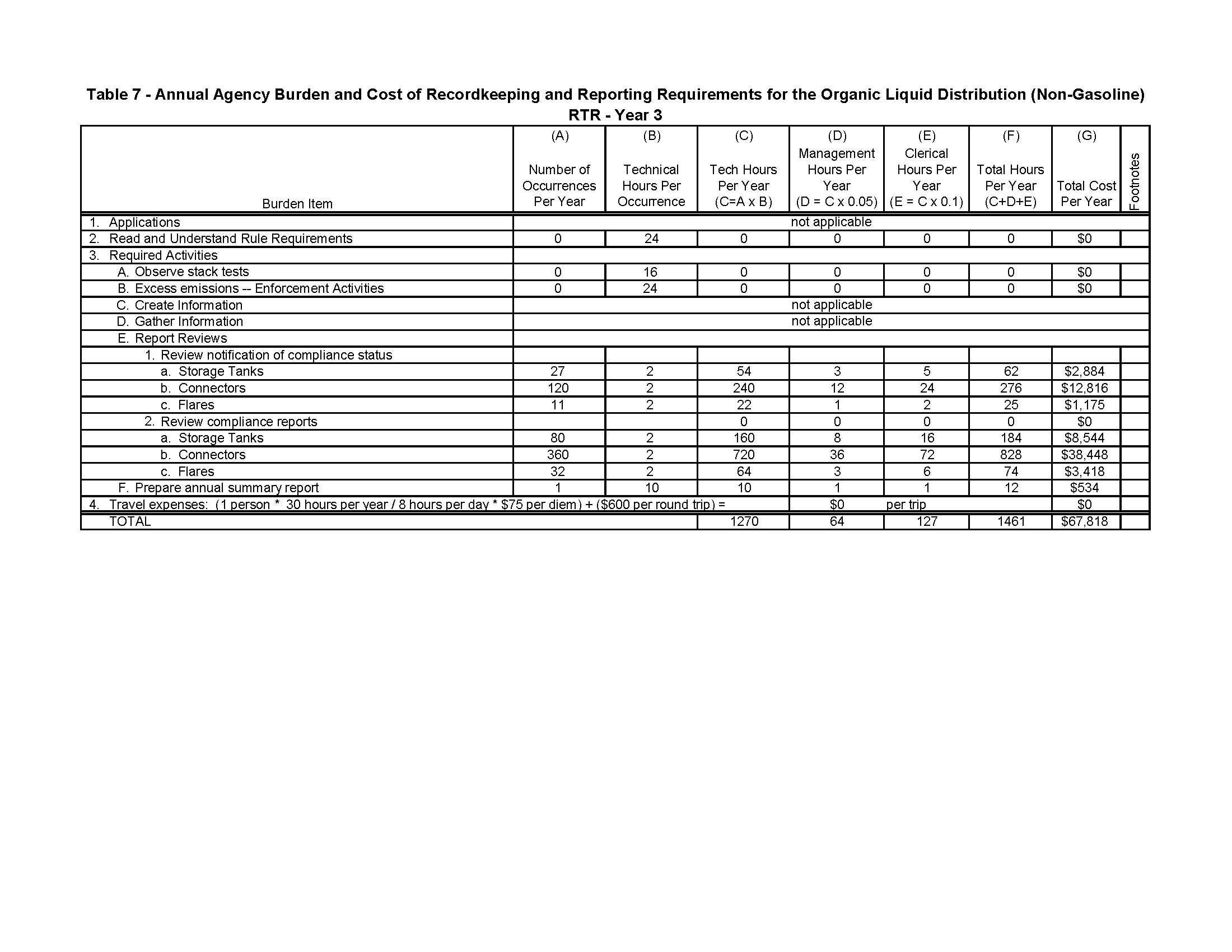
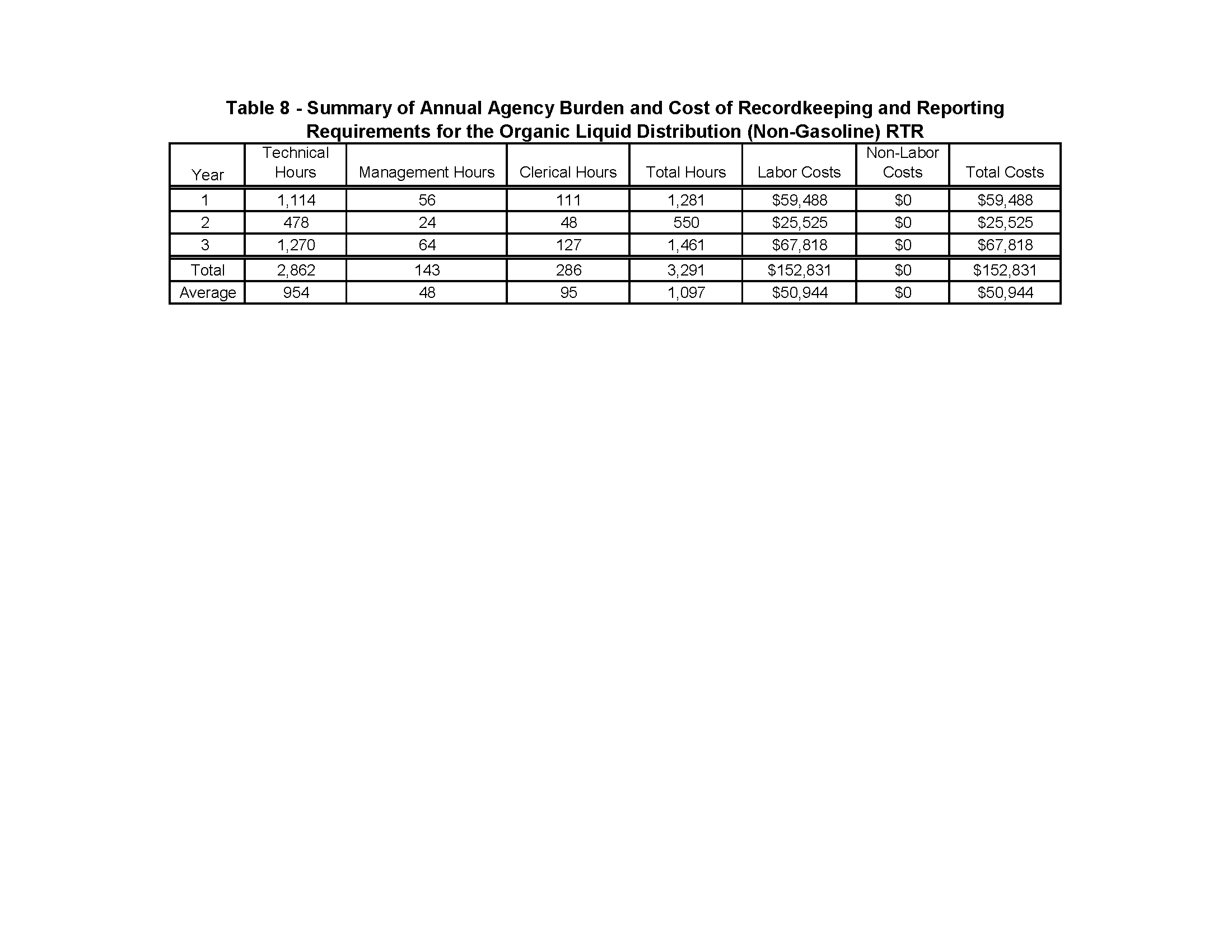
| File Type | application/vnd.openxmlformats-officedocument.wordprocessingml.document |
| File Title | SUPPORTING STATEMENT |
| Author | ERG_BML |
| File Modified | 0000-00-00 |
| File Created | 2021-01-15 |
© 2025 OMB.report | Privacy Policy